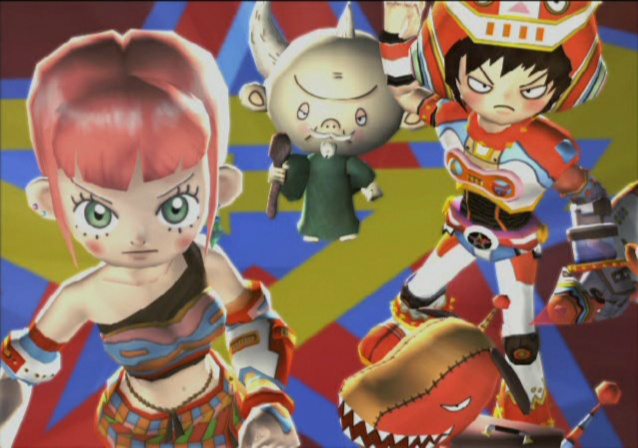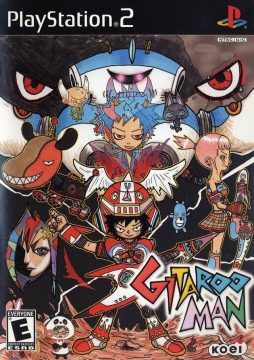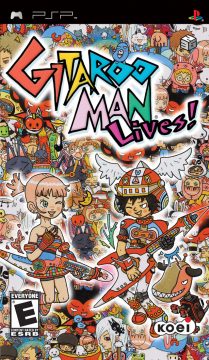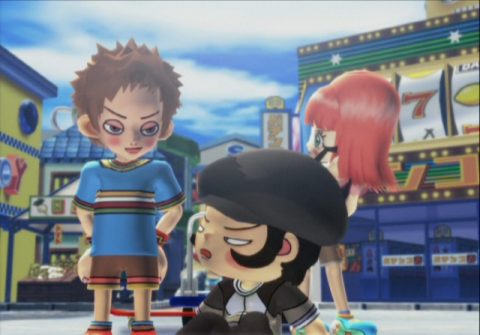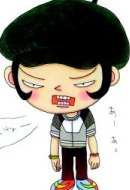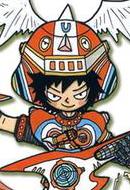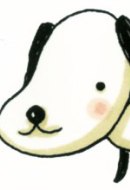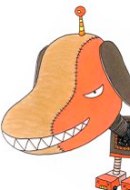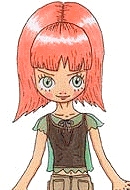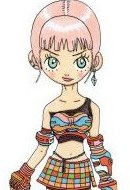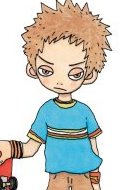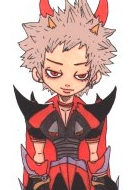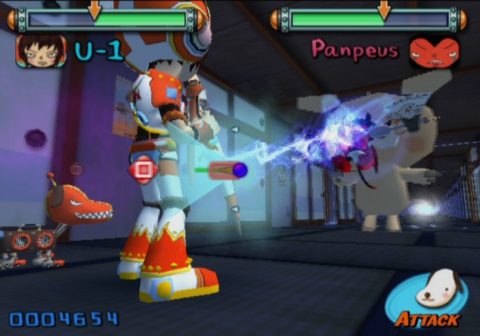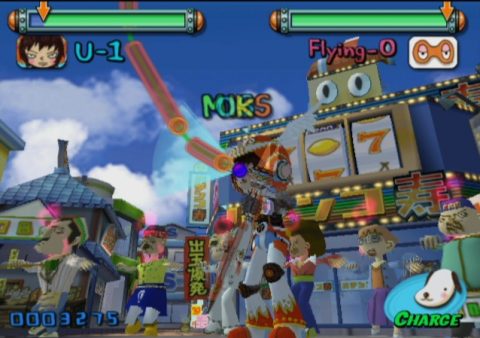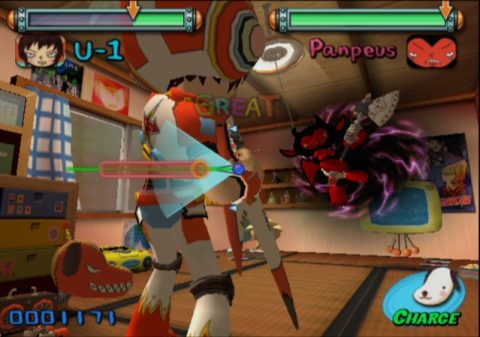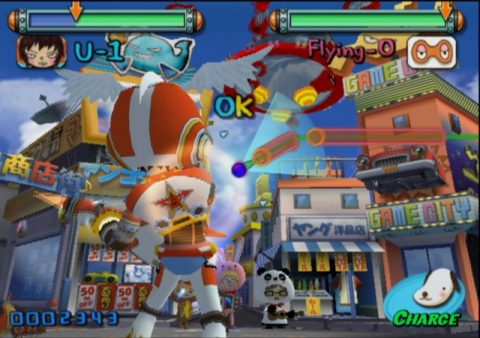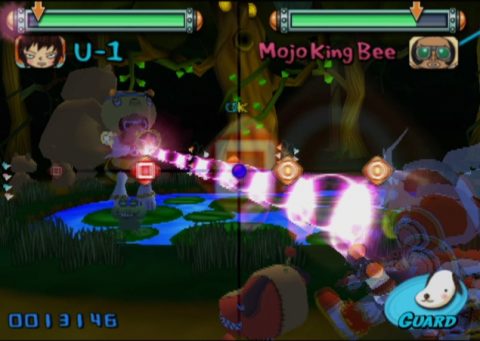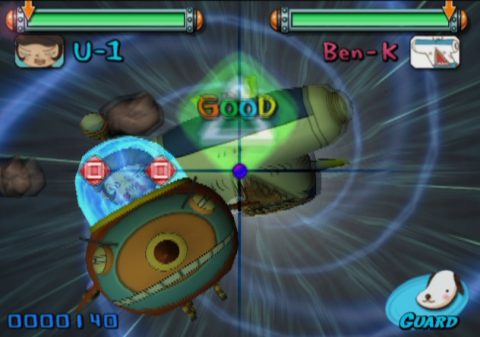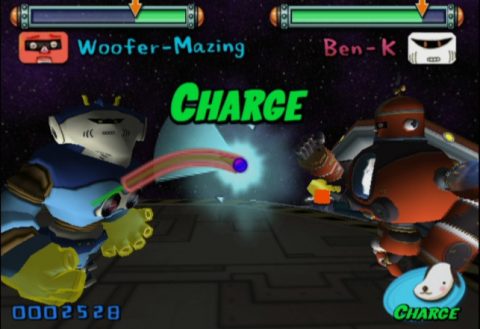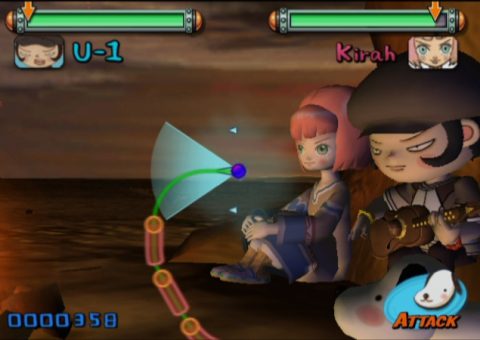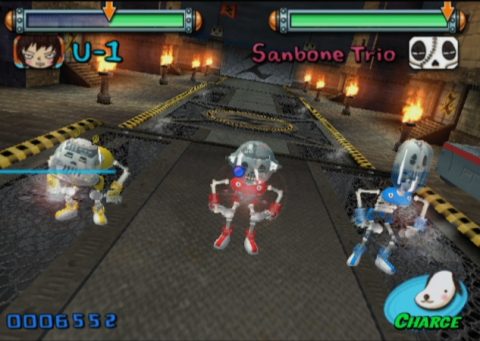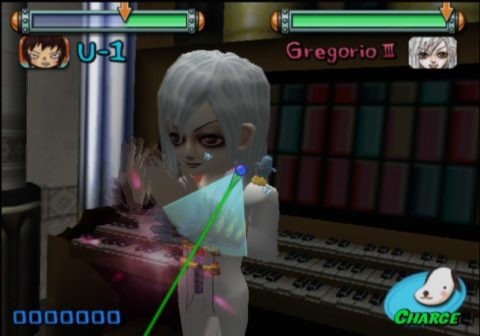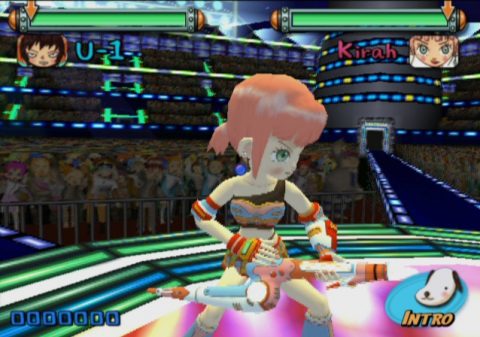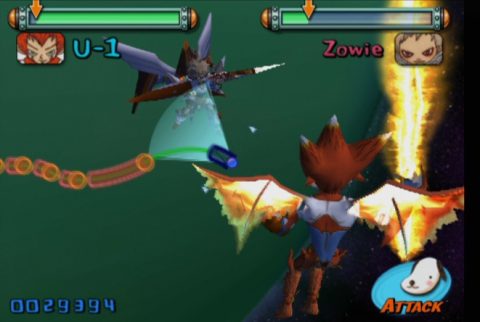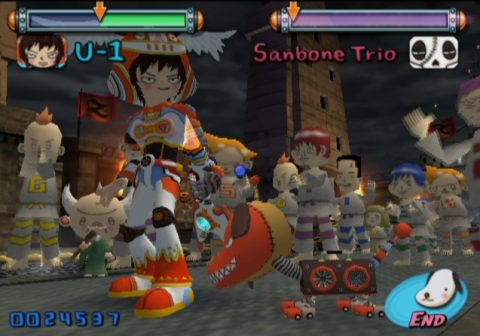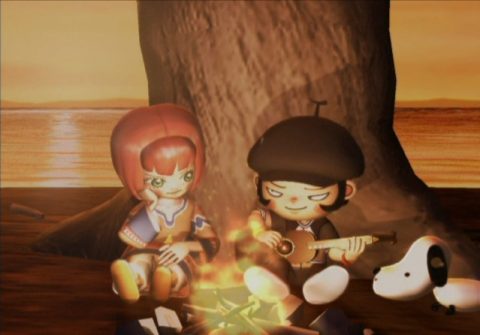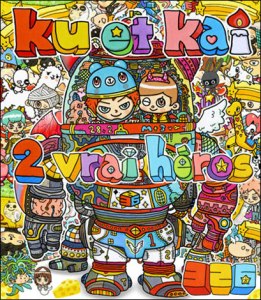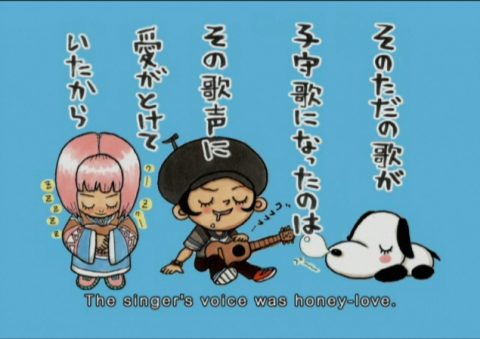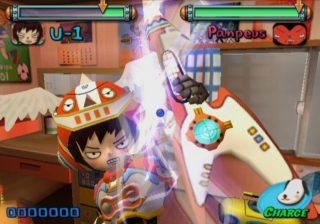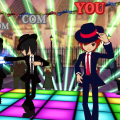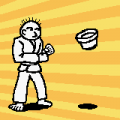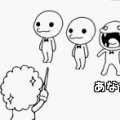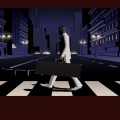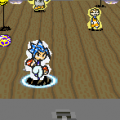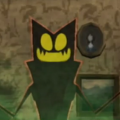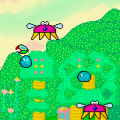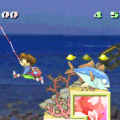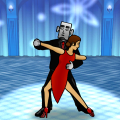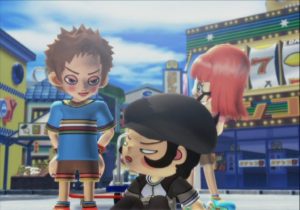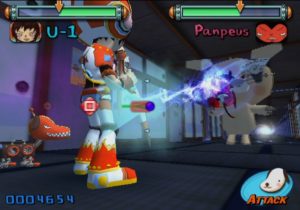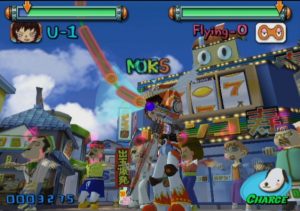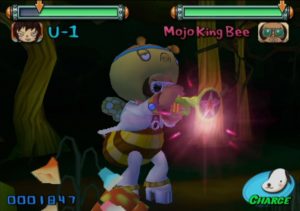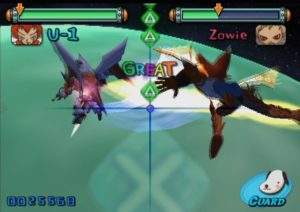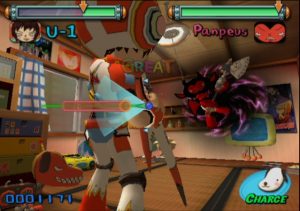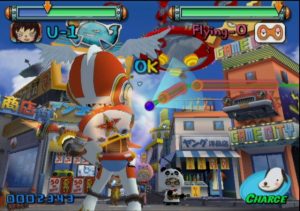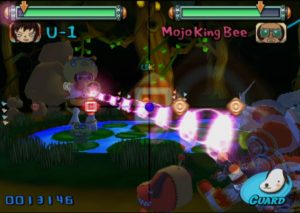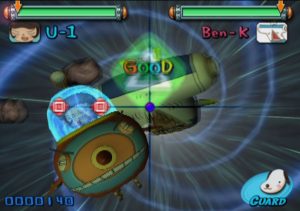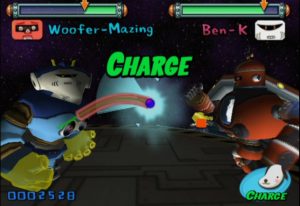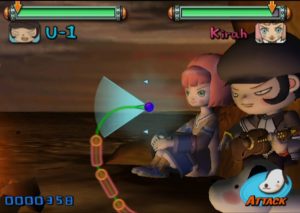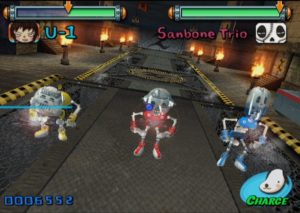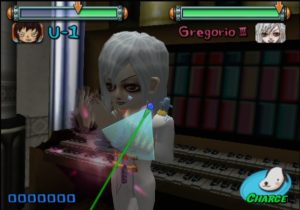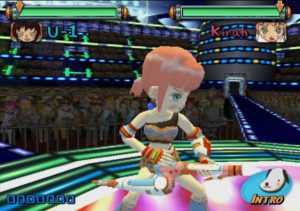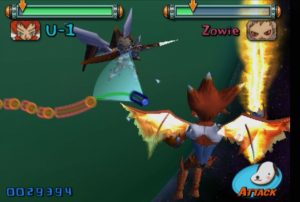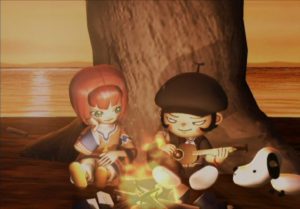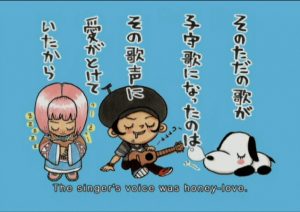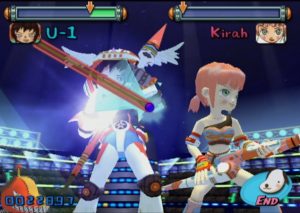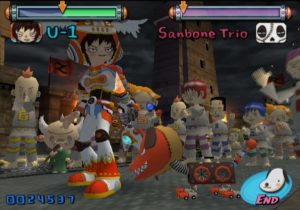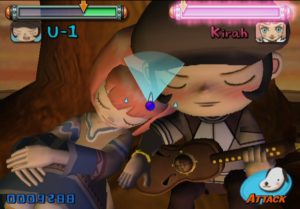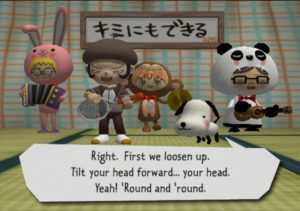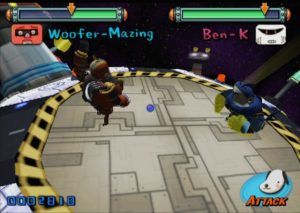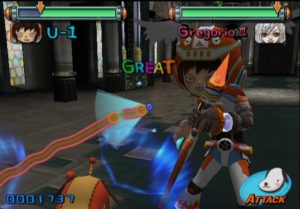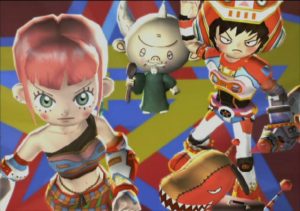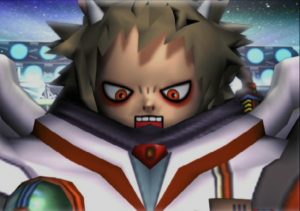The story of Gitaroo Man follows an awkward and clumsy kid named U-1 as he goes from loser to legendary hero. U-1 is a dork on Earth, and he is often ridiculed at school, while also going unnoticed by the girl he admires. This all changes, when the evil Gravillian Empire finds out that U-1 is the owner of the legendary gitaroo, a mystical guitar weapon, and sends goons to steal it away. When U-1 touches the gitaroo, he becomes Gitaroo Man, the champion of Planet Gitaroo. As Gitaroo Man, he faces the Gravillian Empire, and saves the Gitarian people, while also learning a little about love, friendship and self-confidence over his long summer break.
Characters
U-1 / Gitaroo Man
This is the main character. He is a geeky fellow who wants to become a cool kid in order to impress a cute girl at school. However, he usually just gets picked on by the local bully as he is clumsy and lame. His fate changes when he becomes Gitaroo Man. His name seems to be a pun on the rock band, U-2, although U-1 pronounced in Japanese is “Yuichi”, a common male name. Gitaroo Man is U-1’s alter ego. Gitaroo Man is a master of guitar music and he uses his skills to battle the forces of evil across the galaxy.
Puma
Puma is U-1’s trusty pet. He gives advice, and watches your back. When U-1 becomes Gitaroo Man, Puma changes into a robot boombox called AC30 to amplify his buddy’s tunes.
Pico / Kirah
U-1’s love interest on Earth. She bears a striking resemblance to Kirah. She is the strongest Gravillian warrior and a master gitaroo player. She appears as a boss late in the game, but U-1 manages to charm her with his impressive musical skills.
Kazuya / Zowie
The ruler of the Gravillian Empire. He looks like Kazuya, a bully from U-1’s class and shares his arrogant attitude. He wants to collect all of the gitaroo weapons, so that he can rule the universe. Zowie also has a cat named Ming Ming.
As one might expect, every battle is fought by playing the guitar. Most of the notes are played by tracing a line with the analog stick, and pressing the X button in time with the riffs. It’s a bit dissimilar from many other rhythm games, because there are no real patterns and no real structure for the songs to follow – you either have to be able to follow the lines or have listened to the song enough to play it roughly by ear. Like most rhythm games, hearing the music played out is part of the reward, through the tracing isn’t exactly the best mechanic – it’s far too easy to lose grip due to how finicky it is. There’s also absolutely no room for freestyling at all, though that’s to be expected for games like this. It’s more involved than Parappa the Rapper and UmJammer Lammy, though not quite as involving as Ouendan. There are occasional segments where you need to hit other face buttons in rhythm with the song, which scroll from the edges of the screen towards the center. The gameplay never strays from this, but while it may seem simple initially, it gets surprisingly hard fairly quickly.
Most stages consist of three phases: charge, battle, and final. In the charge phase, each correctly played note increases U-1’s health gauge. The battle phase has the player pressing specific button sequences to dodge enemy attacks. In the battle phase, U-1 also has to correctly play various notes in order to damage his enemy. The final phase occurs when the enemy is severely weakened, and usually involves U-1 playing a long solo until the enemy is defeated and the stage is cleared. The phases don’t ultimately mean a whole lot – they don’t change based on the flow of the battle or whether you’re winning or losing, and are just present to give the feeling that you’re actually staging a rock duel against an opponent.
Each stage is scored according to how many misses and hits are achieved. The ranking goes from E to S, with each rank unlocking a new item in the Collection menu. After beating the Story mode once, a new mode called Master’s Play unlocks on the main menu. This mode complicates the song arrangements and offers some new remixes as well. Master’s Play mode is brutally challenging, but it is a nice bonus feature that adds some variety and replay value to an already great game.
Gitaroo Man‘s Story Mode has ten stages, all of which have different musical themes that range from Eurobeat to Metal to Reggae. The stages themselves are the real treat as most of them are utterly insane. For example, after the opening tutorial, an alien appears in U-1’s bedroom brandishing an ax. U-1’s dog, Puma, tosses him the gitaroo which transforms him into Gitaroo Man. As Gitaroo Man, he battles the alien as his bedroom turns into this warping, quasi music video of a child’s nightmare world featuring random events such a giant dancing pig and a berserk flying train.
Stage 1
Opponent: Panpeus
Song: Twisted Reality
This devil takes the “guitar=axe” metaphor a little bit too seriously, as he invades U-1’s room. His song is slow rock.
Stage 2
Opponent: Flying-O
Song: Flyin’ to your Heart
This UFO turns the townspeople into dancing fools. His weapon is essentially a keytar. This synthy, poppy song, by Chinese group YUAN, is a blend of Chinese, Japanese and English. In the PSP version, the song is entirely in English.
Stage 3
Opponent: Mojo King Bee
Song: Bee Jam Blues
Out of nowhere pops a man in a bee suit! This song is a funky, bluesy tune.
Stage 4
Opponent: Ben-K
Song: VOID
As U-1 and Puma fly through the warp they are chased by this giant mechanical shark. The music is drum and bass. There is no attacking in this stage, just dodging.
Stage 5
Opponent: Ben-K
Song: ‘Nuff Respect, featuring NAHKI
A true face off against Ben-K done in reggae style as he transforms into a robot form, and U-1 follows suit.
Stage 6
Opponent: Kirah
Song: The Legendary Theme (Acoustic)
U-1 reaches Planet Gitaroo, where he meets up with Kirah and plays her a soothing melody under a tree. You are technically fighting for her heart (awwwww!) as she cuddles up next to U-1.
Stage 7
Opponent: Sanbone Trio
Song: Born to be Bone
U-1 is initially left defenseless against this skeleton trio until Puma can escape and give him his Gitaroo. This song has a heavy Latin American influence, with percussion played on various instruments, like xylophones, metal drums, and cymbals.)
Stage 8
Opponent: Gregorio “Siegfried” Wilhelm III
Song: Tainted Lovers
This makeup-caked pretty boy has a flair for the dramatic, as he is fought in a fancy church in front of a gigantic organ. His song is a heavy metal rock opera.
Stage 9
Opponent: Kirah
Song: Overpass / The Legendary Theme (Album version)
U-1 and Kirah are set to duel each other, but U-1 refuses to fight. He convices Kirah to rebel against the Gravillian by joining him in a duet of a remix of The Legendary Theme.
Stage 10
Opponent: Zowie
Song: Resurrection
A dramatic battle fought in the sky, as Zowie in his Armored Gitaroo faces off against U-1 in his ultimate form.
Duet Stage 1
Opponent: Kai-Kakoon
Song: Metal Header
Found only in the PSP version in the seperate Duet mode, apart from the main story. It’s a fairly standard guitar piece, not nearly as good as the main songs.
Duet Stage 2
Opponent: Ming Ming
Song: Toda Pasión
Also found only in the PSP version in the Duet mode, Ming Ming flies a huge ship with its own pair of bongos, amongst other instruments. The song is Latin flavored.
As this is a music based game, the soundtrack needs to be quite strong, and luckily it is not just adequate, the soundtrack is amazing. Gitaroo Man succeeds with pumping tunes like the second stage’s “Flyin’ to Your Heart”, but it also achieves a rarity in gaming soundtracks, making wonderfully mellow tunes like the acoustic, “Legendary Theme”. This song not only makes that particular stage very memorable, with U-1 finally wooing the girl of his dreams, but it also gives this game a brilliant atmosphere. This special atmosphere is one of the reasons this game is so likeable, because it feels like a breath of fresh air that was created with actual heart and soul.
Of special note, the character designs are very unique, and go along way toward adding charm to somewhat ho-hum graphics. The character designer is a Japanese poet and pop artist known as 326 (Mitsuru Nakamura). He is a self-taught illustrator with a very original style that works well within the strange Gitaroo Man universe. 326 also worked on the manga, Ku and Kai, which looks very similar to Gitaroo Man aesthetically.
Gitaroo Man is not without its flaws. First, the game’s English voice acting is amateurish and some characters are particularly grating, such as an old man in one of the later stages that keeps yelling worthless advice over top of the music. Also one glaring design flaw is the inability to pause without being forced to start the entire stage over, which is annoying and aggravating if you need to take a small break from the game.
A trial version called Gitaru Man Wan (Gitaroo Man One) was released prior to the full game in Japan. This special PlayStation 2 CD-Rom features the original TGS trailer, alternate recordings of some songs, an art gallery, and a mini-game starring Puma. Each copy of this game came with three collectible cards. With these cards, players could play Gitaroo Man themed janken (Japanese for Paper, Rock, Scissors.)
Gitaroo Man was originally a very rare game after its initial release due to Koei giving it a very small print run. However, in 2005 the game was re-printed (in North America), thus making it much easier to acquire. Gitaroo Manis a fantastic alternative to popular music games like Rock Band and Guitar Hero, because of its zany cast and great original music. It is a single player experience that can be beaten in under an hour if you are skilled enough, but expect to come back for more, as this game and its soundtrack truly inspires more than one playthrough.
In 2006, Koei ported Gitaroo Man to the PlayStation Portable, which features the entire PS2 version with additional features. A Versus mode has been added which uses the PSP wireless network for local multiplayer support. In this mode, players can compete against one another or cooperate against a computer opponent in Duet mode; another neat feature here is the ability to use a computer controlled partner if you don’t have a pal around with an extra copy of Gitaroo Man Lives!, since the game sadly does not allow game sharing. Duet Mode also adds two new songs, Metal Header and Toda Pasion, however neither song is particularly notable when compared with the rest of the soundtrack. In addition to these new features, the game now has a Jukebox menu, which is basically a Sound Test option, and Theater mode, which allows the player to review story cut-scenes. It also features an English version of “Flyin’ To Your Heart”, the second stage song.
Graphically, Gitaroo Man Lives! is practically identical to the PS2 release, although at a choppier framerate (30 FPS compared to 60 FPS in the PS2 version) and lower resolution, although in a widescreen display. Unfortunately, this also means long load times. The control is a bit more forgiving to compensate for the crappy analog nub of the PSP, although it’s still not quite comfortable. Koei did fix the pausing issue from the original game, as players can now pause and resume in the same place instead of being forced to start the entire stage over, and there’s an Easy mode as well. Overall, Gitaroo Man Lives! is a strong port of a great game, and it stands as one of the best rhythm games available on PSP.
Gitaroo Man has a soundtrack and drama CD available. The soundtrack consist of 11 tracks, most of which are performed by the band COIL, but it does not contain the Master Mode remixes or the new songs added in the PSP version. A cell phone game titled Gitaroo Man Ai was released in Japan. This game featured U-1’s dog, Puma, collecting various drinks in mini-games that unlock pictures and songs. AC-30 Puma also appears as a trinket in the game Kessen 2.
